Tēnā koutou and nau mai, haere mai to High Country Matters.
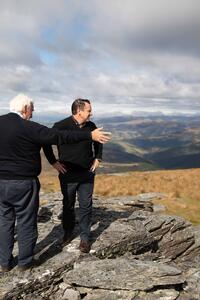
Jerome Sheppard – Deputy Chief Executive, Crown Property
Since our last update, there has been progress on the Crown Pastoral Land Reform Bill.
As some of you will be aware, the Environment Select Committee recently presented its report on the Bill.
The Committee recommended several changes to the Bill after considering extensive feedback from leaseholders, iwi, interest groups and the wider public.
View the latest version of the Bill.
Minister for Land Information Damien O’Connor recently provided an update on the Bill and the changes recommended by the Committee to Farmers Weekly. If you missed it, you can view it on page 40 of Farmers Weekly, 12 July 2021.
The Bill will now proceed to a second reading. At this stage, the Government’s intention is that the Bill is passed before the end of the year. We will keep you updated as it continues through the Parliamentary process.
In the meantime, we are continuing with tenure review and recently reached agreements for Grampians and Godley Peaks. We share the outcome about these reviews in this issue and provide an update about our pastoral lease visits, which I’m pleased are up even more this year.
We also have an update about our High Country Advisory Group, a profile on Nick Sinclair-Butterick in our pastoral team, and the latest on Te Manahuna Ki Uta/the Destination Mackenzie project.
I hope you enjoy this issue and I welcome any feedback you may have. Please feel free to share this newsletter with anyone else who may be interested.
Heoi anō tāku mō nāianei,
Jerome Sheppard – Deputy Chief Executive, Crown Property
Rise in pastoral lease visits
Our pastoral team got out and about on pastoral leases even more over the last year.
The team is responsible for administering 162 Crown pastoral leases that span 1.2 million hectares in the South Island high country.
Pastoral Team Manager April Hussey says over the last year (between July 2020 and June 2021) the team carried out 109 visits over 80 different leases for a range of purposes, including property inspections and to process consents. This was up 51 percent on the previous year, which saw 72 visits completed over 54 leases.
“I’m proud that we’ve managed to complete even more visits this year and we look set to achieve our commitment to visit each pastoral lease at least once every two years.
“It’s been great connecting with our leaseholders on the land to find out what they are doing and how we can help.”
April says the team was also contacted more by leaseholders this year and felt the visits were contributing to strengthening the partnership.
She says visits slow down at this time of year, due to poor weather conditions, but will ramp up again in the spring/summer. The team liaises with leaseholders to schedule visits around farming commitments, including lambing, shearing and mustering.
“A key focus for the team over the coming months will be supporting leaseholders come to terms with any new requirements under the Crown Pastoral Land Reform Bill.”
There will be an opportunity for leaseholders, iwi and the public to provide feedback on any new regulations developed as part of implementing the Bill.

A view across part of Cecil Peak Station, in Southland
Tenure review continues
We continue our work on tenure review and recently reached agreements for The Grampians and Godley Peaks pastoral leases.
The agreements will see around 18,000 hectares in the Mackenzie Basin, home to a range of threatened plants, birds, fish and insects, become conservation land.
Find out more about the outcome of these reviews - Tenure review agreements expand conservation land in Mackenzie Basin.
The tenure review agreements for Huxley Gorge I and II, as well as Island Hills, in Canterbury, have also recently been implemented and the land designated for conservation transferred to the Department of Conservation.
While the Government made the decision to end tenure review in 2018, the process is ongoing until the Crown Pastoral Land Reform Bill comes into effect. At that point, tenure review will end the day after the Bill is passed, except for pastoral leases at the substantive proposal stage.
There are currently 27 properties in tenure review.
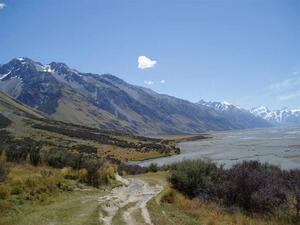
Upper Godley Valley
New High Country Advisory Group
Earlier this year, we announced the new members of our High Country Advisory Group.
Jim Greenslade, Tom Pinckney, Kerry Harmer, Donna Field, Ray Grubb, Cordelia Woodhouse and Professor Bill Lee were appointed as new members, while Jonathan Wallis, Di Lucas and Jen Miller were reappointed to provide continuity to the group.
A key consideration when appointing the group was ensuring we had a range of representatives, including iwi, environmental experts and a number of farmers.
“It’s important for us to hear a range of perspectives as we work to understand, develop and care for the iconic high country,” says LINZ Chief Executive Gaye Searancke.
More information on the group, including profiles on the members.

The first HCAG meeting for 2021
Meet the team – Nick Sinclair-Butterick

Nick flying over Matukituki pastoral lease
When did you join Toitū Te Whenua LINZ?
I joined in 2015, starting out in the survey team before joining the pastoral team in 2018.
What attracted you to work at Toitū Te Whenua?
My initial role with the survey team sounded unique and challenging. The opportunity to join the pastoral team allowed me to build on those skills, get involved with a wider range of work, meet new people and get out of the office and into the high country.
What do you enjoy about working at Toitū Te Whenua?
The variety is definitely a drawcard. It’s great working with a wide range of people who have a passion for the high country and achieving the best outcomes for the land.
I’m lucky to be part of a great team and have lessees who are very hospitable.
Have you always had an interest in the South Island high country?
Yes, growing up in the South Island enjoying the mountains and lakes has been a privilege and this role has provided many opportunities to see so much more.
Can you tell us a bit about yourself and your background?
I grew up in Ashburton, lived in Dunedin for a number of years, then had brief stints in Lake Tahoe and London before moving to Christchurch. I’ve held a wide range of roles, including working at a meatworks, an engineering firm rebuilding combine harvesters, folding shirts on Savile Row, bumping chairs at ski-fields (in the USA and NZ) and managing a campus library.
What interests/hobbies do you have outside of work?
I have two young boys (aged three and one), so they take up most of my time! Outside of work I enjoy football, playing the guitar and snowboarding.
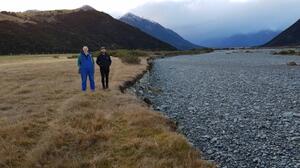
Mt Algidus farm manager Peter Angland, left, and Nick on the Canterbury pastoral lease
Did you know
Did you know that some scenes in the hit Netflix show Sweet Tooth were filmed on Rees Valley Station pastoral lease in Otago?
In fact, the entire series – about a half-boy, half-deer, named Gus who leaves his home in the forest to find the outside world ravaged by a cataclysmic event – was filmed here in Aotearoa New Zealand.
Sweet Tooth isn’t the first time Rees Valley Station has provided breath-taking backdrops for film.
The landscapes also feature in Mission Impossible 6, X-Men Origins and Vertical Limit, to name a few.
To find out more about some of the other Kiwi connections in the show, check out this story by One News, or visit the New Zealand Film Commission who have some interesting facts, including that 80 percent of the cast are New Zealanders.

(Left to right) Stefania Lavie Owen as Becky, Christian Covery as Gus and Nonso Anozie as Tommy Jepperd in the hit TV series Sweet Tooth. Photo: Netflix©.
Have your say on the future of the Mackenzie
A 100-year vision for the Mackenzie District is being developed and you can have your say.
The feedback is being collated as part of Te Manahuna Ki Uta/the Destination Mackenzie project.
The project, led by the Mackenzie District Council, involves developing a long-term vision for the district and Destination Management Plan to support the tourism industry, while protecting the natural values that make the area an attraction to locals and visitors.
Your feedback will be used to help shape the plans for the district. Click here to find out more and have your say.
Toitū Te Whenua is proud to be a part of the project alongside partners Te Rūnanga o Arowhenua, Te Rūnanga o Waihao, Te Rūnanga o Moeraki, Ministry of Business, Innovation and Employment, Department of Conservation, Waka Kotahi NZ Transport Agency, and the Mackenzie Development Group.
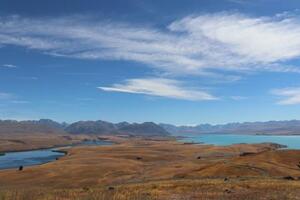
A view across the Mackenzie.
Thousands of images captured in tahr survey
Tens of thousands of images were captured during a pilot survey of tahr numbers on Crown pastoral leases within the tahr feral range.
The aerial survey was conducted by Toitū Te Whenua and DOC late last year as part of efforts to learn more about the tahr population within the feral range – a legal boundary where tahr are allowed.
Pastoral Team Manager April Hussey says more than 16,000 images were captured by a high resolution camera mounted to a plane that surveyed 28 Crown pastoral leases.
“The survey proved invaluable in testing a new monitoring method and enabled us to get a better idea of numbers across the feral range.
“The results found 489 tahr on a small number of the pastoral leases, with most at low altitudes.”

Tahr captured during a test flight over public conservation land before the survey
April says while tahr were only found on a limited number of leases, given the relatively small area surveyed and the highly clustered nature of these animals, the average number detected per hectare surveyed was relatively high at 4 tahr/km2. Under the Himalayan Thar Control Plan 1993, tahr densities should not exceed 5 tahr/km2.
“To put these results in context, we may conduct further surveys in the future.
“In the meantime, we’re developing a policy for tahr management on Crown pastoral leases. We will share the draft policy with leaseholders soon for them to provide feedback.”
One fun thing – Unbaa-lievable
We thought this was a bit ewe-nique and couldn’t help but shear it.
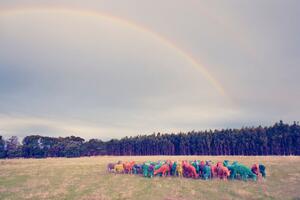
These cool pics were captured by photographer Gray Malin.
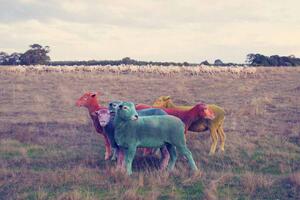
Have you ever dyed any of your sheep? Email pastoraltenure@linz.govt.nz to let us know!
Media contact
Email: media@linz.govt.nz